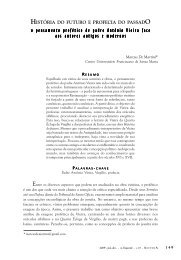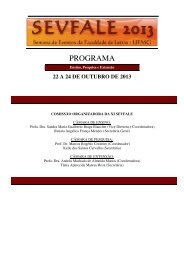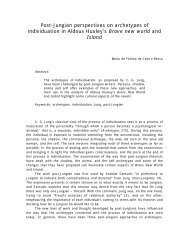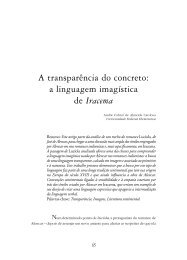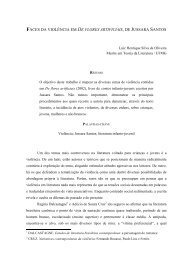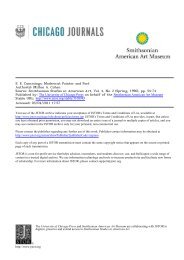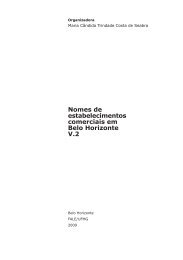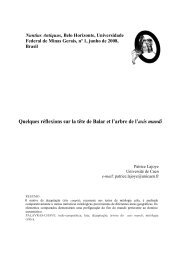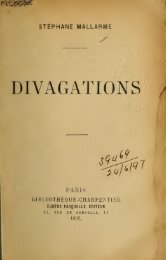Contornos do Indizível: o estilo de Clarice Lispector - Fale - UFMG
Contornos do Indizível: o estilo de Clarice Lispector - Fale - UFMG
Contornos do Indizível: o estilo de Clarice Lispector - Fale - UFMG
You also want an ePaper? Increase the reach of your titles
YUMPU automatically turns print PDFs into web optimized ePapers that Google loves.
Em Tese, Belo Horizonte, v. 10, p. 196-201, <strong>de</strong>z. 2006<br />
struggle to overcome all racist mistreatments they faced during slavery times, but also<br />
the struggle of all African Americans, until the present time. Ryan reveals that:<br />
To read Morrison’s Beloved is necessarily to ask what it means to be black and African<br />
<strong>de</strong>scen<strong>de</strong>d in a largely white America […] It is to ask how the long story of mistreatment<br />
of one social group by another weighs upon the present. And it is to confront the ghosts of<br />
one’s culture, the ghost of the overseer, and the ghost of the slave as well as to remember<br />
what shouldn’t be forgotten. (148)<br />
These ghosts pointed out by Ryan in Morrison’s Beloved are remarkably present<br />
in African American political, cultural, and social lives, until the present. Morrison<br />
wakes up those ghosts that have been haunting American society for so long. In the<br />
novel, the ghost of Sethe’s daughter is a metaphor for all those slaves who suffered<br />
with the atrocities of slavery. This novel opens important questionings concerning the<br />
way African American culture, traditions, and history have been misun<strong>de</strong>rstood,<br />
distorted, and erased from a white official history and discourse. Beloved goes beyond<br />
a white historiographical perspective and shows a different point of view. It negotiates<br />
a re-reading of American history, that is, it can instigate a conscious reflection and, as<br />
Ryan (148) puts it, a possible “reconsi<strong>de</strong>ration of the history of white discourse from<br />
an interracial perspective”. Through a conscious reading of Beloved some chapters of<br />
American History, for instance Slavery, can be discussed and reevaluated not only<br />
through white eyes, but also through African Americans’ own eyes.<br />
Morrison’s narrative structure in Beloved illustrates how she portrays the<br />
character Beloved in or<strong>de</strong>r to represent those thousands of slaves who were forgotten<br />
and had their (hi)stories neglected and erased from people’s minds. Morrison’s<br />
narrative voice points out:<br />
Everybody knew what she was called, but nobody anywhere knew her name […] Although<br />
she has claim, she was not claimed […] They forgot her like a bad dream […]<br />
Remembering seemed unwise […] They can touch it if they like, but they <strong>do</strong>n’t, because<br />
they know things will never be the same if they <strong>do</strong>. (274-75)<br />
Such poetic words reveal a claim for justice that is ignored because of the<br />
consequences that it can provoke. The way Morrison <strong>de</strong>picts Beloved’s presence<br />
throughout the novel as being “sad”, “grief”, “lonely” and “rebuked” (8, 9, 13), and<br />
also the way Beloved’s actions showed how she craved Sethe’s love and presence<br />
emphasize Beloved’s connection with the other <strong>de</strong>ad slaves who had their stories<br />
abruptly interrupted and were <strong>de</strong>prived of the love of their mothers and families.<br />
Through the personal (hi)stories of her characters, Morrison reveals how slaves<br />
were <strong>de</strong>prived of their mates, children, and family connections. For instance,<br />
Morrison’s narrative voice gives the testimony of how Baby Suggs’s family as well as<br />
other people she knew “had been hanged, rented out, loaned out, bought up, brought<br />
back, stored up, mortgaged, won, stolen or seized” (23). The novel exposes physical<br />
and psychological scars, lynching, mur<strong>de</strong>ring, and the humiliation of millions of people<br />
who were seen as objects of exchange.<br />
Morrison’s processes of remembering and re-membering the African American<br />
past represent a possibility of re<strong>de</strong>mption and healing of physical and psychological<br />
wounds. 1 Morrison’s main characters have to rememorize and face their past in or<strong>de</strong>r<br />
to get maturity, release their personal and collective traumas, and transform their own<br />
present.<br />
Morrison remembers and re-presents slavery and its traumas as a very personal<br />
and real experience. 2 Morrison’s novel, which combines facts and fiction, has an<br />
extraordinary sense of place, history, and community. Her novel presents dates, places<br />
Disponível em http://www.letras.ufmg.br/poslit<br />
197



